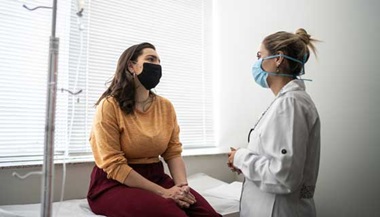Endoscopic Sleeve Gastroplasty
A procedure to address obesity, endoscopic sleeve gastroplasty can reduce the size of the stomach without the need for an incision through the skin.
What You Need to Know
- Endoscopic sleeve gastroplasty (ESG) is also called an accordion procedure.
- It is performed with an endoscope, which is a flexible tube equipped with small stitching instruments that help reduce the size of the stomach.
- ESG may be appropriate for people with a body mass index of 30 or more and for whom diet and exercise alone have not worked.
- Because the procedure is minimally invasive, there is less risk of complications than with open or laparoscopic surgery. ESG is potentially reversible.
- Like other weight loss procedures, ESG works best and achieves long-term success and lasting weight loss, when you commit to a healthier lifestyle.
What is endoscopic sleeve gastroplasty?
Endoscopic sleeve gastroplasty is a minimally invasive weight loss procedure that uses an endoscopic suturing (stitching) device to reduce the stomach’s size and volume by about 70%.
When your stomach holds less volume, you can feel full with less food, absorb fewer calories and lose weight over time. ESG also shortens and re-shapes the stomach, which helps it empty into the intestines slower. This helps you feel fuller longer.
For the right candidate, ESG may be a less invasive alternative to laparoscopic sleeve gastrectomy. Both procedures reduce the stomach size, but the surgical approach does so by removing part of the stomach, while ESG uses stitches to bring folds of the stomach together like an accordion (similar to sewing a dart to tailor clothing). Endoscopic sleeve gastroplasty is reversible for most patients.
What Happens During the Endoscopic Sleeve Gastroplasty (ESG) Procedure?
Who might be a candidate for endoscopic sleeve gastroplasty?
The endoscopic sleeve gastroplasty procedure may be an option for adults who:
- Have a body mass index (BMI) of 30 or higher (a sign of obesity)
- Have not had success with lifestyle modifications such as diet and exercise
- Are looking for an alternative to more invasive bariatric surgery
- Are prepared to make a commitment to a healthier lifestyle
ESG can be part of a plan to reduce the risk of weight-related illness such as high blood pressure, diabetes, fatty liver disease, sleep apnea or heart disease. This procedure is especially effective when combined with a program that includes behavioral therapy, exercise and dietary changes.
ESG may not be suitable for people with conditions including stomach ulcers, large hiatal hernias and bleeding disorders.
ESG After Laparoscopic Sleeve Gastrectomy or a Previous ESG
In some cases, ESG can be used to help restart weight loss after laparoscopic sleeve gastrectomy – a procedure that removes part of the stomach, shaping it like a narrow sleeve. Over time, this sleeve can stretch, allowing a person to consume more food, which can lead to weight gain. ESG can further reduce the size of the stomach to help you stay on track with your weight loss plan.
ESG can also be repeated after a few years, once the stomach has stretched out after the previous ESG or the endoscopic sutures have loosened.
Endoscopic Sleeve Gastroplasty Versus Gastric Bypass
Other surgical procedures besides ESG that can help people lose weight by reducing the stomach’s volume include laparoscopic gastric sleeve and roux-en-Y gastric bypass. Unlike endoscopic sleeve gastroplasty, a gastric bypass requires incisions to be made through the skin, and it makes more drastic changes to the anatomy.
With gastric bypass, a part of the stomach is separated into a small pouch, which is then connected to the small intestine. Food travels through the small pouch and bypasses the rest of the stomach. With sleeve gastroplasty, the connection between the stomach and intestine does not change. This can result in a shorter recovery time, less pain and fewer complications.
Because gastric bypass involves more changes to anatomy than endoscopic sleeve gastroplasty, it can lead to greater weight loss but is associated with more risks and side effects. Common side effects after stomach-reducing procedures include anemia, vitamin deficiencies and dumping syndrome, which are more common after a bypass than after a gastroplasty.
Your doctor will help you compare risks and benefits of these and other procedures and help you choose the right weight loss approach.
Preparing for Endoscopic Sleeve Gastroplasty
Before the endoscopic sleeve gastroplasty, your doctor may ask you to have some laboratory tests.
The doctor will discuss specific instructions you will need to follow before the procedure. They can include:
- Fasting from midnight the day before the procedure
- Temporary changes in your medications before and after the procedure
Johns Hopkins Endoscopic Weight Loss Program
The team with the Endoscopic Weight Loss Program offers innovative weight loss procedures that do not require invasive surgery. We take a collaborative approach to obesity management that combines the expertise of many specialists, which helps us offer high-quality care and enable long-term weight loss.
What happens during endoscopic sleeve gastroplasty?
The ESG takes place in an endoscopy suite while you are asleep under general anesthesia. It lasts about 90 minutes.
The procedure is performed using an endoscope — a flexible tube with a light, camera and an endoscopic suturing device attached. The tiny camera allows the doctor to see and operate inside the stomach without making incisions in the abdomen.
To perform endoscopic sleeve gastroplasty:
- The doctor inserts the endoscope into your mouth, down the throat and into the stomach.
- Lines are drawn along the stomach’s front and back walls, where sutures will be placed.
- With a running stitch pattern, the doctor uses the endoscope to place approximately eight sutures (stitches) in the stomach.
- The doctor tightens the sutures, drawing the front and back walls of the stomach together to reduce its volume by about 70%.
The sutures change the structure of the stomach, leaving it shaped like a tube or sleeve (hence the name sleeve gastroplasty). The sutures do not dissolve — your stomach tissue will heal around them to form the new shape. It is safe for the sutures to remain in your body, and they can be removed later if the procedure needs to be reversed.
With less volume in your stomach, you will feel full after eating less food, absorb fewer calories and lose weight.
Recovery After ESG
Most people go home the same day of an ESG. Others need to spend a night or more in the hospital for observation. Someone must drive you home when you are released.
Endoscopic Sleeve Gastroplasty Diet
Your doctor will provide detailed instructions on what to eat and not to eat while you recover from ESG and get used to the smaller stomach volume. Dietary restrictions during the first few weeks may include the following.
- First eight hours: no food — only clear liquids
- First week: liquid diet with powdered protein, no caffeine or alcohol
- Second week: Add soft foods (those that can be mashed with a fork) that are low in sugar and fat
- After a month: You can usually start eating small portions of solid food
Although the types of food you can eat will not be restricted once you recover from ESG, following a diet that emphasizes healthy and nutritious foods will help you achieve better results. Your doctor or nutritionist will provide information on how to adopt healthy eating habits. Their recommendations may include:
- Eat slowly so you don’t overfill your stomach, causing discomfort.
- Chew your food well.
- Stay hydrated.
- Stop eating when you feel full.
- Eat smaller portions (no more than a cup of food during each meal).
- Continue focusing on foods that are low in sugar, fat and calories.
Endoscopic Sleeve Gastroplasty Complications and Side Effects
You might experience a stomachache, nausea and vomiting after the procedure, but this is usually temporary. If necessary, your doctor will give you medication to reduce these symptoms while you recover.
Because ESG is a minimally invasive operation, the risk of serious complications such as the following is very small.
- Bleeding
- Infection (your doctor may give you antibiotics before the procedure to lower the risk)
- Tears in the stomach
- Abscess (a pocket of infection)
- Leaking of stomach contents into the chest or abdominal cavity
- Pulmonary embolism (a blood clot in the lung)
- Pneumoperitoneum (a bubble of air or gas in the abdominal cavity)
- Pneumothorax (collapsed lung)
Endoscopic Sleeve Gastroplasty Results
People who had endoscopic sleeve gastroplasty lose approximately 12% to 20% of their body weight within one year.
It is important to understand that although the procedure is effective, the best weight loss results are achieved by people who participate in an integrated support program. Endoscopic sleeve gastroplasty helps you control your appetite while you establish new eating habits, and it works best in conjunction with behavioral therapy, exercise and nutritional guidance.







